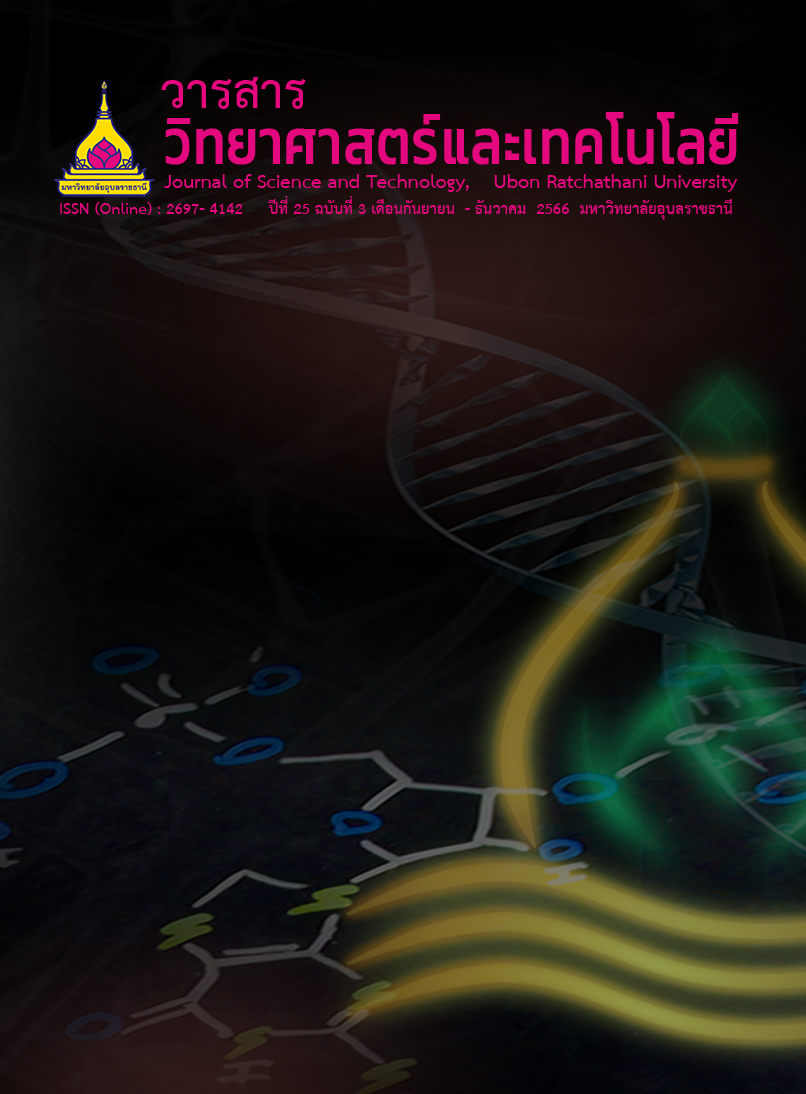การศึกษาสภาวะที่เหมาะสมในการผลิตเครื่องดื่มน้ำนมถั่วเหลืองโดยวิธีพื้นผิวตอบสนอง
Main Article Content
บทคัดย่อ
งานวิจัยนี้มีวัตถุประสงค์เพื่อศึกษาสภาวะที่เหมาะสมในการผลิตเครื่องดื่มน้ำนมถั่วเหลืองโดยวิธีพื้นผิวตอบสนอง วางแผนการทดลองแบบ Box-Behnken Design เพื่อศึกษาปัจจัยที่มีผลต่อคุณภาพของผลิตภัณฑ์ 3 ปัจจัย คือ อุณหภูมิ เวลา และปริมาณของคาราจีแนน ในกระบวนการผลิตถั่วเหลือง โดยอุณหภูมิ เวลา และปริมาณคาราจีแนนที่ใช้ คือ 80-100 องศาเซลเซียส, 15-30 นาที และร้อยละ 0.00-0.08 ตามลำดับ จากนั้นศึกษาคุณภาพ (ทางกายภาพ เคมี และจุลินทรีย์) และประเมินคุณภาพทางประสาทสัมผัสของผลิตภัณฑ์ รวมทั้งทำนายจุดที่เหมาะสมของค่าตอบสนองโดยใช้โปรแกรมทางสถิติในการสร้าง response surface plot จากการทดลองพบว่าในทุกสภาวะ ปริมาณเชื้อจุลินทรีย์ทั้งหมด ยีสต์และรา อยู่ในเกณฑ์มาตรฐานที่ปลอดภัยต่อผู้บริโภค ส่วนสภาวะที่เหมาะสมต่อการผลิตน้ำนมถั่วเหลือง คือ ต้มที่อุณหภูมิ 92.47 องศาเซลเซียส เป็นเวลา 24.56 นาที และใช้ปริมาณคาราจีแนนเท่ากับร้อยละ 0.041 ซึ่งมีผลทำให้น้ำนมถั่วเหลืองที่ได้มีปริมาณโปรตีนสูง มีความหนืดอยู่ในระดับที่ผู้บริโภคยอมรับ และมีค่าคะแนนความชอบโดยรวมสูง นอกจากนี้ยังพบว่าค่าตัวแปรตาม (ปริมาณโปรตีน และค่าความหนืด) ที่ทำนายจากสมการมีค่าใกล้เคียงกับค่าที่ได้จากการทดลอง
Article Details

อนุญาตภายใต้เงื่อนไข Creative Commons Attribution-NonCommercial-NoDerivatives 4.0 International License.
บทความที่ได้รับการตีพิมพ์เป็นลิขสิทธิ์ของ วารสารวิทยาศาสตร์และเทคโนโลยี มหาวิทยาลัยอุบลราชธานี
ข้อความที่ปรากฏในบทความแต่ละเรื่องในวารสารวิชาการเล่มนี้เป็นความคิดเห็นส่วนตัวของผู้เขียนแต่ละท่านไม่เกี่ยวข้องกับมหาวิทยาลัยอุบลราชธานี และคณาจารย์ท่านอื่นๆในมหาวิทยาลัยฯ แต่อย่างใด ความรับผิดชอบองค์ประกอบทั้งหมดของบทความแต่ละเรื่องเป็นของผู้เขียนแต่ละท่าน หากมีความผิดพลาดใดๆ ผู้เขียนแต่ละท่านจะรับผิดชอบบทความของตนเองแต่ผู้เดียว
เอกสารอ้างอิง
Saah, N., Chedoloh, R. and Adair, A. 2015. Production and properties of fish crackers substituted with soybean meal. Journal Development of Community and Life Quality. 3(3): 351-359. (in Thai)
Pichairat, D. and Mahae, N. 2017. Effect of fish meat substitution with soybean meal in Palaw Keropok. Rajamangala University of Technology Srivijaya Research Journal. 9(2): 197-211. (in Thai)
Verma, V., Chauhan, O.P. and Nanjappa, C. 2019. Optimization process for the development of soymilk-based strawberry rts beverages. Plant Archives. 19(Special): 972-5210.
Qin, P., Wang, T. and Luo, Y. 2022. A review on plant-based proteins from soybean: Health benefits and soy product development. Journal of Agriculture and Food Research. 7: 100265.
Sangsopha, J. and et al. 2019. Optimization of pasteurized milk with soymilk powder and mulberry leaf tea based on melatonin, bioactive compounds and antioxidant activity using response surface methodology. Heliyon. 5(11): e02939.
dos Santos, D.C. and et al. 2019. Optimization of soymilk fermentation with kefir and the addition of inulin: Physicochemical, sensory, and technological characteristics. LWT-Food Science and Technology. 104: 30-37.
Oyedeji, A.B., Mellemand, J.J. and Ijabadeniyi, O.A. 2018. Improvement of some quality attributes of soymilk through optimization ofselected soybean sprouting parameters using response surface methodology. CyTA-Journal of Food. 16(1): 230-237.
Yang, Y. and et al. 2020. Effect of the heating process on the physicochemical characteristics and nutritional properties of whole cotyledon soymilk and tofu. RSC Advances. 10: 40625-40636.
Updiskul, S. 1994. Experimental Design 2. 2nd edition. Bangkok: Kasetsart University. (in Thai)
Association Official Analytical Chemists (AOAC). 2000. Official Method of Analysis of AOAC International. 17th edition. Gaithersburg, MD: AOAC International.
Chaiyarit, M., Techawongstien, S. and Nampila. R. 2018. Effect of peeling and citric acid on quality of Jerusalem artichoke (Helianthus tuberosus L.) Kaentawan #2 during storage. Khon Kaen Agriculture Journal. 46(6): 1115-1122. (in Thai)
Tang, J. 2013. Physicochemical and Sensory Properties of Soymilk from Five Soybean Lines. M.Sc. Thesis, University of Missouri-Columbia.
Akkarachaneeyakorn, S., Nititanatorn, S. and Likhitwanichakul, S. 2021. Effect of soybean preparation methods on physicochemical and sensory properties of soy milk and effect of drying temperatures and maltodextrin concentrations on quality of spray-dried soy milk powder. The Journal of Applied Science. 20(1): 137-153. (in Thai)
Thai Industrial Standards Institute, Ministry of Industry. 2015. Thai Community Product Standard: Soy Bean Milk (TCPS. 529/2015). Bangkok: Thai Industrial Standards Institute, Ministry of Industry. (in Thai)
Suphamityotin, P. 2011. Optimizing enzymatic extraction of cereal milk using response surface methodology. Songklanakarin Journal of Science and Technology. 33(4): 389-395.
Bai, Y., Wilson, L.A., and Glatz, B.A. 1998. Quality of commercial shelf-stable soymilk products. Journal of Food Protection. 61(9): 1161-1164.
Rattanachak, N. and et al. 2019. Development of healthy soy milk product by using sucralose and Hom Nin broken rice. The Science Journal of Phetchaburi Rajabhat University. 16(2): 49-59. (in Thai)
Taew-Teing, S. 2009. Soy Milk Product Mixed with Carrot Juice. M.Ed. Thesis: Rajamangala University of Technology Phra Nakhon. (in Thai)
Phoonphun, S. 2004. Effect of Gelling Agents on Quality Attributes of Strawberry Flavoured Milk Jelly Drink. M.Sc. Thesis: Silpakorn University. (in Thai)


